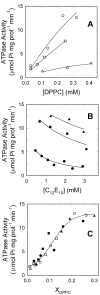A two-stage model for lipid modulation of the activity of integral membrane proteins
- PMID: 22723977
- PMCID: PMC3378530
- DOI: 10.1371/journal.pone.0039255
A two-stage model for lipid modulation of the activity of integral membrane proteins
Abstract
Lipid-protein interactions play an essential role in the regulation of biological function of integral membrane proteins; however, the underlying molecular mechanisms are not fully understood. Here we explore the modulation by phospholipids of the enzymatic activity of the plasma membrane calcium pump reconstituted in detergent-phospholipid mixed micelles of variable composition. The presence of increasing quantities of phospholipids in the micelles produced a cooperative increase in the ATPase activity of the enzyme. This activation effect was reversible and depended on the phospholipid/detergent ratio and not on the total lipid concentration. Enzyme activation was accompanied by a small structural change at the transmembrane domain reported by 1-aniline-8-naphtalenesulfonate fluorescence. In addition, the composition of the amphipilic environment sensed by the protein was evaluated by measuring the relative affinity of the assayed phospholipid for the transmembrane surface of the protein. The obtained results allow us to postulate a two-stage mechanistic model explaining the modulation of protein activity based on the exchange among non-structural amphiphiles at the hydrophobic transmembrane surface, and a lipid-induced conformational change. The model allowed to obtain a cooperativity coefficient reporting on the efficiency of the transduction step between lipid adsorption and catalytic site activation. This model can be easily applied to other phospholipid/detergent mixtures as well to other membrane proteins. The systematic quantitative evaluation of these systems could contribute to gain insight into the structure-activity relationships between proteins and lipids in biological membranes.
Conflict of interest statement
Figures




Similar articles
-
Modulation of plasma membrane Ca2+-ATPase by neutral phospholipids: effect of the micelle-vesicle transition and the bilayer thickness.J Biol Chem. 2015 Mar 6;290(10):6179-90. doi: 10.1074/jbc.M114.585828. Epub 2015 Jan 20. J Biol Chem. 2015. PMID: 25605721 Free PMC article.
-
Slow Phospholipid Exchange between a Detergent-Solubilized Membrane Protein and Lipid-Detergent Mixed Micelles: Brominated Phospholipids as Tools to Follow Its Kinetics.PLoS One. 2017 Jan 24;12(1):e0170481. doi: 10.1371/journal.pone.0170481. eCollection 2017. PLoS One. 2017. PMID: 28118404 Free PMC article.
-
Spontaneous Reconstitution of Functional Transmembrane Proteins During Bioorthogonal Phospholipid Membrane Synthesis.Angew Chem Int Ed Engl. 2015 Oct 19;54(43):12738-42. doi: 10.1002/anie.201504339. Epub 2015 Aug 28. Angew Chem Int Ed Engl. 2015. PMID: 26316292 Free PMC article.
-
How lipids interact with an intrinsic membrane protein: the case of the calcium pump.Biochim Biophys Acta. 1998 Nov 10;1376(3):381-90. doi: 10.1016/s0304-4157(98)00010-0. Biochim Biophys Acta. 1998. PMID: 9804995 Review.
-
General and specific lipid-protein interactions in Na,K-ATPase.Biochim Biophys Acta. 2015 Sep;1848(9):1729-43. doi: 10.1016/j.bbamem.2015.03.012. Epub 2015 Mar 16. Biochim Biophys Acta. 2015. PMID: 25791351 Review.
Cited by
-
Conformational dynamics of a neurotransmitter:sodium symporter in a lipid bilayer.Proc Natl Acad Sci U S A. 2017 Mar 7;114(10):E1786-E1795. doi: 10.1073/pnas.1613293114. Epub 2017 Feb 21. Proc Natl Acad Sci U S A. 2017. PMID: 28223522 Free PMC article.
-
Modulation of plasma membrane Ca2+-ATPase by neutral phospholipids: effect of the micelle-vesicle transition and the bilayer thickness.J Biol Chem. 2015 Mar 6;290(10):6179-90. doi: 10.1074/jbc.M114.585828. Epub 2015 Jan 20. J Biol Chem. 2015. PMID: 25605721 Free PMC article.
-
The membrane protein LeuT in micellar systems: aggregation dynamics and detergent binding to the S2 site.J Am Chem Soc. 2013 Sep 25;135(38):14266-75. doi: 10.1021/ja405984v. Epub 2013 Sep 16. J Am Chem Soc. 2013. PMID: 23980525 Free PMC article.
-
Kinetics and thermodynamics of membrane protein folding.Biomolecules. 2014 Mar 18;4(1):354-73. doi: 10.3390/biom4010354. Biomolecules. 2014. PMID: 24970219 Free PMC article. Review.
-
Kinetic stability of membrane proteins.Biophys Rev. 2017 Oct;9(5):563-572. doi: 10.1007/s12551-017-0324-0. Epub 2017 Sep 18. Biophys Rev. 2017. PMID: 28921106 Free PMC article. Review.
References
-
- Singer SJ, Nicolson GL. The fluid mosaic model of the structure of cell membranes. Science. 1972;175:720–731. - PubMed
-
- Lee AG. Biological membranes: the importance of molecular detail. Trends in Biochemical Sciences. 2011;36:493–500. - PubMed
-
- Hunte C, Richers S. Lipids and membrane protein structures. Curr Op Struct Biol. 2008;18:406–411. - PubMed
Publication types
MeSH terms
Substances
LinkOut - more resources
Full Text Sources

